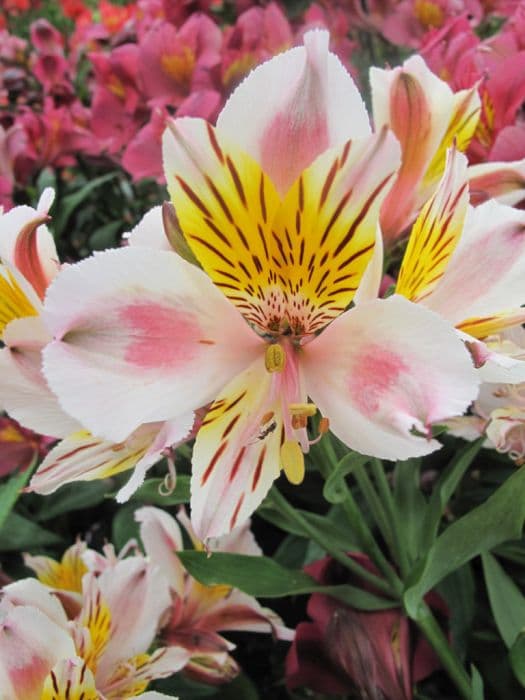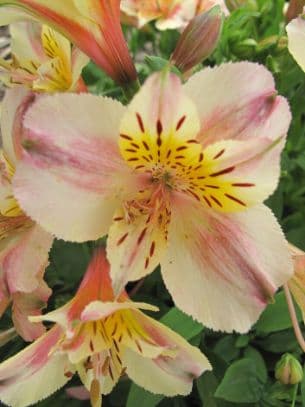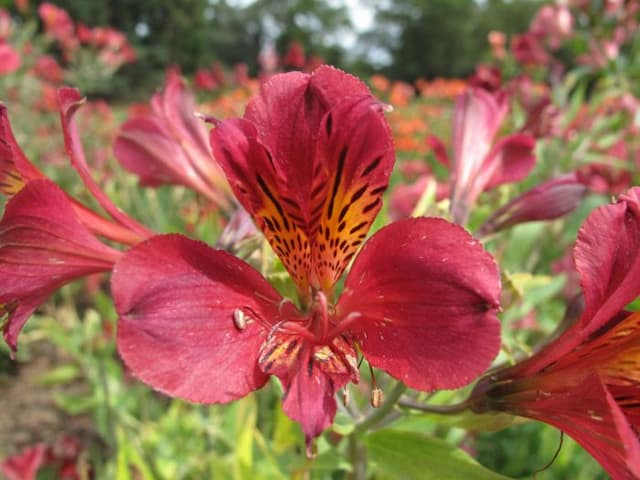Peruvian Lily Alstroemeria 'Roselind' (Little Miss Series)

ABOUT
The Alstroemeria 'Roselind' from the Little Miss Series, commonly known as Peruvian Lily or Lily of the Incas, exhibits a vibrant and captivating appearance typical of its kind. This plant is adorned with striking, funnel-shaped flowers, each exhibiting a blend of soft pink petals that often feature intricate flecks and streaks of a deeper pink or burgundy hue, giving them an exceptionally decorative look. These blossoms are known for their delicate appearance and are arranged in clusters, which creates a lush, bouquet-like effect. The foliage of the Peruvian Lily 'Roselind' is equally attractive, composed of slender, lance-shaped leaves that are a glossy green. These leaves are known to twist and turn, giving the plant an interesting and dynamic texture. The leaves and flowers together form a harmonious and colorful display which is often seen as a highlight in gardens and floral arrangements. It is important to note that these characteristics are presented without reference to the specific dimensions or growth habit of the plant in terms of its size.
About this plant
 Names
NamesFamily
Alstroemeriaceae
Synonyms
Peruvian Lily, Lily of the Incas, Parrot Lily
Common names
Alstroemeria 'Roselind' (Little Miss Series).
 Toxicity
ToxicityTo humans
The plant commonly known as Peruvian Lily is not highly toxic to humans. However, like many plants, it can cause mild irritation if ingested. The sap of Peruvian Lily contains compounds that may cause skin irritation or allergic reactions upon contact for some individuals. If any part of the plant is ingested, it could potentially cause mild gastrointestinal upset such as nausea or vomiting.
To pets
The Peruvian Lily is mildly toxic to pets, including cats and dogs. If ingested, it can cause gastrointestinal upset such as vomiting or diarrhea. The sap can also be an irritant, potentially causing dermal reactions if pets come into contact with the plant. Care should be taken to discourage pets from chewing on any part of the Peruvian Lily.
 Characteristics
CharacteristicsLife cycle
Perennials
Foliage type
Deciduous
Color of leaves
Green
Flower color
Mixed
Height
1-2 feet (30-60 cm)
Spread
1-2 feet (30-60 cm)
Plant type
Bulb
Hardiness zones
7
Native area
South America
Benefits
 General Benefits
General Benefits- Vibrant Blossoms: Alstroemeria 'Roselind' produces vividly colored flowers that enhance the visual appeal of gardens and landscapes.
- Long Blooming Period: This plant has a prolonged blooming season, providing color and interest for an extended time.
- Attracts Pollinators: The flowers attract beneficial insects like bees and butterflies, supporting local ecosystems.
- Cut Flower Use: The blooms are excellent for cutting and arranging in vases, maintaining their beauty for several days.
- Drought Tolerance: Once established, Alstroemeria 'Roselind' can tolerate periods of drought, reducing the need for frequent watering.
- Low Maintenance: It requires minimal upkeep beyond the initial planting and occasional watering, making it a practical choice for gardeners of all levels.
- Frost Resistance: Alstroemeria 'Roselind' is resistant to light frost, which can help it survive in cooler climates.
- Versatility: Suitable for planting in borders, containers, and as part of a mixed bed, offering flexibility in garden design.
 Medical Properties
Medical PropertiesThis plant is not used for medical purposes.
 Air-purifying Qualities
Air-purifying QualitiesThis plant is not specifically known for air purifying qualities.
 Other Uses
Other Uses- Gift Plant: Alstroemeria can be potted and given as a sustainable gift alternative to cut flowers, as it can bloom multiple times with proper care.
- Photography Subject: The vibrant and detailed blossoms of the Alstroemeria make it an ideal subject for macro photography and botanical art.
- Educational Use: Alstroemeria can be used in botany classes to teach students about plant anatomy, reproduction, and hybridization processes.
- Symbolic Decoration: In various cultures, Alstroemeria represents friendship and devotion, making it suitable for events celebrating these themes.
- Crafting: Dried Alstroemeria flowers can be used in crafting, such as making bookmarks, greeting cards, or pressed flower arrangements.
- Therapeutic Horticulture: Caring for Alstroemeria plants can be part of therapeutic horticulture programs that aim to improve mental well-being through gardening activities.
- Color Dye Source: The pigments in the flowers may be used to create natural dyes for textiles or artworks.
- Fragrance Extraction: Although not a common fragrance source, Alstroemeria’s subtle scent can be part of bespoke perfume-making projects for hobbyists.
- Seasonal Celebrations: The blooms of Alstroemeria can be scattered in ceremonies or festivals that celebrate spring and rebirth.
- Study of Plant Adaptation: Alstroemeria 'Roselind' can be used in studies of how plants adapt to different climate zones and garden conditions.
Interesting Facts
 Feng Shui
Feng ShuiThe Peruvian Lily is not used in Feng Shui practice.
 Zodiac Sign Compitability
Zodiac Sign CompitabilityThe Peruvian Lily is not used in astrology practice.
 Plant Symbolism
Plant Symbolism- Friendship: Alstroemeria, also known as the Peruvian lily or lily of the Incas, often symbolizes strong and enduring friendships, due to the flower's long-lasting nature.
- Wealth: The multiple colors and stripes on Alstroemeria's petals represent a richness of new adventures and fortunes.
- Devotion: With its intertwined leaves that grow closely together, the Alstroemeria signifies mutual support in relationships and devotion between friends or loved ones.
- Achievement: The Alstroemeria's tendency to bloom all year round is seen as a symbol of the perseverance and effort needed to achieve one's goals.
- Prosperity: As a flower that proliferates, the Alstroemeria indicates burgeoning abundance and prosperity in one's life.
 Water
WaterPeruvian lilies, including the 'Roselind', prefer consistent moisture, so it's ideal to water them once a week with about 1 gallon of water. During hot, dry spells, you may need to water twice a week. Always check the top inch of the soil before watering; if it feels dry, it's time to water. Avoid overhead watering to minimize the risk of foliar diseases; instead, aim the water at the base of the plant. Reduce watering frequency in the winter when the plant is not actively growing, but do not allow the soil to completely dry out.
 Light
LightPeruvian lilies thrive in bright, indirect light. They should be placed in a spot where they receive some morning sunlight but are protected from the harsh afternoon sun. An east-facing garden bed or window would be an ideal location, providing them with the perfect balance of light to flourish without getting sunburned.
 Temperature
TemperaturePeruvian lilies can withstand a moderate temperature range, generally preferring conditions between 65 and 80 degrees Fahrenheit. They can survive minimum temperatures down to around 23 degrees Fahrenheit, but frost can damage them. The ideal temperatures for thriving Peruvian lilies would be consistent, moderate daytime temperatures with cooler nights.
 Pruning
PruningPeruvian lilies benefit from regular pruning to remove spent flowers and encourage reblooming. Trim off faded flowers every few weeks during the flowering season to maintain a tidy appearance and stimulate continuous blooms. The best time for more extensive pruning, such as cutting back overgrown plants, is in the late winter or early spring before new growth starts.
 Cleaning
CleaningAs needed
 Soil
SoilPeruvian Lily, or Alstroemeria 'Roselind', thrives best in a well-draining soil mix with a pH of 6.0 to 7.0. A combination of two parts loam, one part sand or perlite, and one part peat or humus is ideal. Regular organic matter additions help maintain fertility and structure.
 Repotting
RepottingPeruvian Lilies should be repotted every two to three years to refresh the soil and accommodate root growth. It's best to repot in the spring or early summer during their active growing phase.
 Humidity & Misting
Humidity & MistingPeruvian Lily prefers moderate humidity levels, around 40-60%. Providing these conditions will help mimic its native environment and support healthy growth.
 Suitable locations
Suitable locationsIndoor
Ensure bright indirect light, keep soil moist, and protect from drafts.
Outdoor
Plant in partial sun, shelter from strong winds, and water regularly.
Hardiness zone
7-10 USDA
 Life cycle
Life cycleAlstroemeria 'Roselind', commonly known as Peruvian Lily or Lily of the Incas, begins its life cycle as a dormant rhizome, which sprouts in early spring. The sprouting stage sees the emergence of linear, lance-shaped leaves and sturdy stems that will eventually bear flowers. As the plant enters the vegetative stage, it develops a robust root system and foliage, preparing for the blooming phase. The flowering stage occurs typically in late spring to summer, showcasing clusters of trumpet-shaped, pink flowers with speckled markings, a characteristic trait of the Alstroemeria genus. After pollination, the plant sets seed in the form of a capsule that, when mature, releases seeds for propagation, although Alstroemeria is more commonly propagated through division. The plant naturally goes dormant during the colder months, during which above-ground growth dies back, and the rhizome survives underground until the next growing season.
 Propogation
PropogationPropogation time
Spring-Early Summer
Propogation: Alstroemeria 'Roselind', commonly known as Peruvian Lily or Lily of the Incas, can be propagated through division, which is the most popular method. The best time to propagate Peruvian Lilies is in the spring when the plant has emerged from dormancy and is beginning to show new growth. To propagate, carefully lift the clump of tuberous roots out of the ground using a garden fork, taking care not to damage the roots. Gently pull apart the clump into smaller divisions, ensuring each division has at least one or two growth points. Replant these divisions at the same depth they were growing previously, spacing them about 12 to 24 inches apart (30 to 61 centimeters) to provide enough room for growth. Water the new plantings thoroughly to help establish the roots in their new locations.


![Peruvian lily [Princess Carmina]](/_next/image?url=https%3A%2F%2Fplants-admin.emdemapps.com%2Fimages%2Fplants%2F%2Fimages%2F604b5b436505f.png&w=640&q=75)

![Peruvian lily [Inca Glow]](/_next/image?url=https%3A%2F%2Fplants-admin.emdemapps.com%2Fimages%2Fplants%2F%2Fimages%2F604b5e99e48d9.png&w=640&q=75)
![Peruvian lily [Inca Smile]](/_next/image?url=https%3A%2F%2Fplants-admin.emdemapps.com%2Fimages%2Fplants%2F%2Fimages%2F604b5cad8fa91.png&w=640&q=75)
![Peruvian lily [Inticancha Passion]](/_next/image?url=https%3A%2F%2Fplants-admin.emdemapps.com%2Fimages%2Fplants%2F%2Fimages%2F604b5f7a78c8d.png&w=640&q=75)


